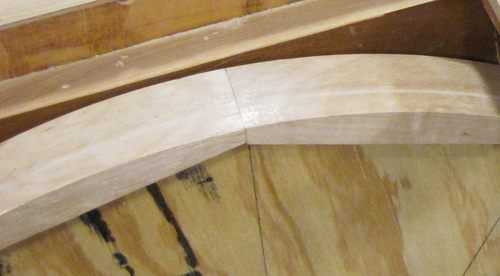 For a while I figured my home made bandsaw didn't need
any sort of bandsaw tires. My bandsaw wheel experiments
seemed to work just fine without tires.
For a while I figured my home made bandsaw didn't need
any sort of bandsaw tires. My bandsaw wheel experiments
seemed to work just fine without tires.
I did run into a problem where the aggressively set teeth of my 1/4" blade cut into the wooden wheel a little bit, but once I stoned the sides of the teeth, that problem went away.
I wasn't happy with how loud my bandsaw was, and listening to parts of it carefully, I realized a lot of noise came from where the blade rolled on and off the wheels.
So I bought a 16-inch and a 14-inch inner tube to see how just an inner tube
stretched around the rim would do as a tire.
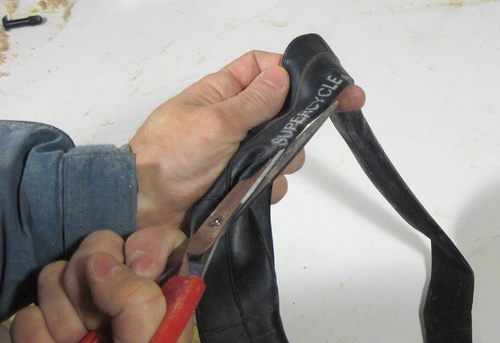 I cut out the inner tube valve and then cut the tube
open along the line that would be facing the rim if it were on a bicycle.
This left me with a piece of rubber that sort of resembled a
very very floppy and stretchy bicycle tire.
I cut out the inner tube valve and then cut the tube
open along the line that would be facing the rim if it were on a bicycle.
This left me with a piece of rubber that sort of resembled a
very very floppy and stretchy bicycle tire.
I then washed the inner tubes. They seem to have some powder-like substance on
the inside of them, and I figure the presence of that would just make them
more likely to slip on the wheels.
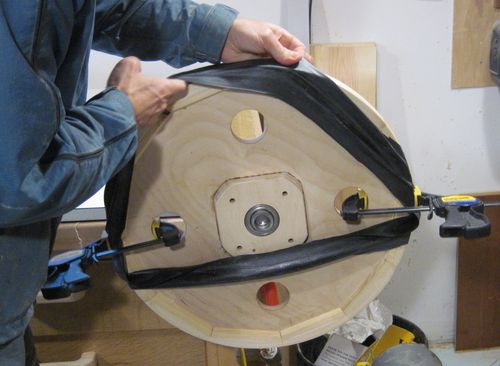 I was able to stretch the inner tube around the 18-inch wheels. The 14-inch tube was a
bit of a challenge because it needed a lot of stretching to reach around the wheel.
But it fit much tighter than the 16-inch tube.
I was able to stretch the inner tube around the 18-inch wheels. The 14-inch tube was a
bit of a challenge because it needed a lot of stretching to reach around the wheel.
But it fit much tighter than the 16-inch tube.
To get the tube around the wheel, I hooked it over the rim and clamped it in place with a clamp. I then took the center of the remaining free loop and clamped that to the opposite edge with another clamp. With the tube clamped on two sides, I only had to worry about stretching it over half the rim at a time. It also made it easier to ensure that I'd tensioned the tube evenly all around.
Note the wooden flanges in this photo - It was taken later. The metal flanges
started to 'creak' a little against the wood when I experimented with higher
bandsaw tension
I replaced the metal flanges with wooden ones, which I glued onto the wheel.
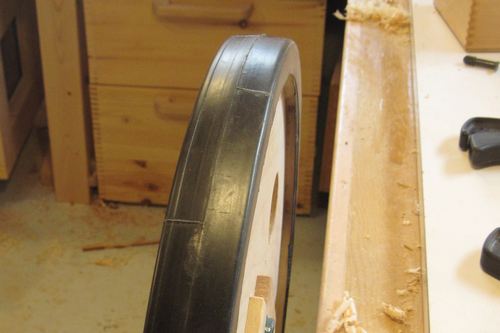 My inner tubes had some slight ridges on them, probably from joints in the mold that
they were made in. I made sure one of these ridges fell exactly along the peak
of the crown on my wheel. If that ridge were to wave back and forth it would probably
cause the same effect as if my crown wasn't consistent and straight.
My inner tubes had some slight ridges on them, probably from joints in the mold that
they were made in. I made sure one of these ridges fell exactly along the peak
of the crown on my wheel. If that ridge were to wave back and forth it would probably
cause the same effect as if my crown wasn't consistent and straight.
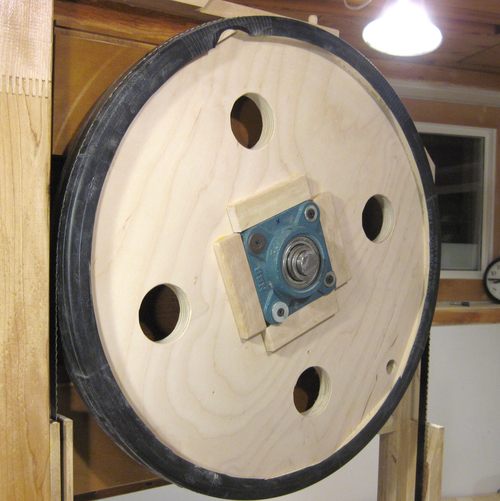 Even without any sort of glue, I found that my inner tubes stayed in place surprisingly
well. In fact, I never detected any slippage of the inner tubes.
On inspecting the lower wheel after considerable use, I realized that the tube
was actually a little bit stuck
to the wheel. I guess it's the effect that rubber, if pressed against a smooth surface
long enough will eventually stick to it. Its for that same reason that its not
a good idea to paint a garage floor, because the car tires will stick to the paint
when a car is parked and will, at times, pull chunks of paint off the floor
Even without any sort of glue, I found that my inner tubes stayed in place surprisingly
well. In fact, I never detected any slippage of the inner tubes.
On inspecting the lower wheel after considerable use, I realized that the tube
was actually a little bit stuck
to the wheel. I guess it's the effect that rubber, if pressed against a smooth surface
long enough will eventually stick to it. Its for that same reason that its not
a good idea to paint a garage floor, because the car tires will stick to the paint
when a car is parked and will, at times, pull chunks of paint off the floor
So this effect is probably what's causing my tires to not slip even without being
glued on.
But I found the lower wheel, which I'd varnished around the edge, had more adhesion.
So I varnished my upper wheel as well. And for good measure, I put the inner tube tire
on it while the varnish was still wet.
Real bandsaw tires are quite expensive. This trick may not work on regular bandsaws, as regular bandsaw tires are much thicker. Some bandsaws also have the crown profile in the tire, as opposed to the wheel.
Proper bandsaw tires would be better, but I didn't want to spend $60 plus shipping to buy bandsaw tires before doing my initial bandsaw wheel experiments. And after trying the innertube as a tire, I knew those would work well enough. I could have bought an 18" bandsaw for $1200, I decided that my own bandsaw had to cost much less than that, or the effort would be hard to justify. So I never gave "real" bandsaw tires serious consideration.
I'm still not sure if the 14-inch or the 16-inch inner tube is better for my 18-inch wheels. The 14-inch tube is very tight, which is better but much harder to get on. But in my experience, stretched rubber bands deteriorate much faster than un-stretched ones. So time will tell whether this applies to inner tube rubber as well.
Update after some years
After two and a half years, the bandsaw tires are still holding up fine.
The more tightly stretched 14" innertube is less likely to get sawdust caught behind it,
but that is a function of my wheel design. My newer bandsaw design
avoids this problem by not having the wheel widen at the edge.
I did however end up shredding a bandsaw tire once when I had had the blade jump off the wheel on my bandsaw/sawmill